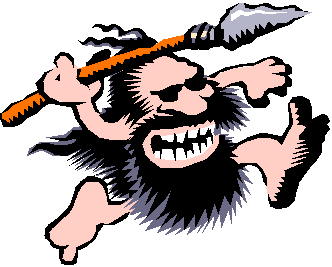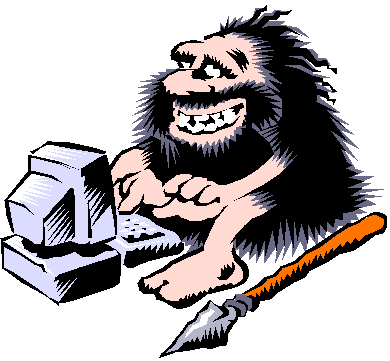
Signals
Consider Thagg, the mighty lion hunter of prehistoric times. Roll your mouse over him and see what happened. Things don't always go as planned.
He thought the lion was asleep. The first signals were electric signals via his eye nerves. His onboard computer (brain, central nervous system) told him the lion was coming and fired another electric signal (somatic portion peripheral nervous system) to his working muscles. This response seems immediate, certainly less than a second. The nerves impulses cause the striated muscles to contract, then a short electric loop between the lower brain and the legs keeps Thagg moving. Nerves send electric signals, the striated (skeletal) muscles contract, that's what they do.
About 3 or 5 seconds after he realizes the lion may be headed further up the food chain than Thagg would prefer, a second set of signals, chemical this time, hit most of Thagg's systems. If he were not running so hard already, he would notice his heart beating very strongly. On the other hand, the blood supply to his skin and organs other than the heart and lungs will decrease. If he gets cut and starts bleeding, he will bleed less after these chemical signals circulate. Impulses from Thagg's brain mobilized a different kind of nervous system, the sympathetic nervous system, which released the hormone, epinephrine, and a related hormone, norepinephrine, into his blood. (We sometimes call these adrenaline and noradrenaline, the British always do.) The epinephrine is released by the sympathetic nervous system very close to smooth muscle that surrounds organs, the norepinephrine into the circulating blood which will prolong the action. This is how epinephrine and norepinephrine work. The circulating chemicals (both are small, water-soluble molecules) contact a receptor on the surface of the cells. The receptor feels the hormone, and its shape changes. The inside of the receptor now becomes an active catalyst and starts to turn on machinery in the cell. Inside the cells, these are called "second messengers."
(Let leave Thagg for a moment and look some more at how this receptor transport process might work. Cell membranes and transport ). Now back to Thagg.
Opps. The lion catches Thagg and wumps him good. Lion takes a bite, but decides Thagg doesn't taste that good. Battered, Thagg crawls back toward his camp, now a long way away. The second day, as hunger, thirst, and pain start to increase, a new set of hormones are released. These hormones are triggered not by the CNS, but by the body's awareness of loss of blood, pain, and stress. These hormones will shut down all the processes not needed for survival. It will conserve salt and water, and shut down inflammation. It will suppress parts of the immune system (Thagg might not live long enough to get an infection). It will accelerate burning of fat and tissues for energy. These hormones are steroid hormones and are not water soluble. They move with the blood by riding in carrier molecules. When these get to the cell, they are transported into the cell, when they migrated, alone or in another carrier molecule, into the cell's nucleus, where they induce production of certain portions of DNA. Unlike the cell surface hormones, these take much longer to have an effect.
Thagg makes it back to camp. Now the lion bite starts to become red and swollen. Probably a bacterial infection from the lions teeth. The pain, redness, swelling, and heat at the site of the bite is known as inflammation. At a molecular level, Thagg has special molecules that resided in the lipid bilayer of his cells. When the cell membrane is disrupted by bacterial enzymes, mechanical damage, or chemical agents, these molecules are released into the fluid surround the cells. A reaction takes place that turns these molecules into a variety of chemical messengers that do lots of things. Nearby blood vessels dilate and become permeable to white blood cells, white blood cells leave the blood and enter the area. Pain, perhaps from damage to the nerves or pressure of swelling, is intensified. Soluble proteins leave the blood, where local enzymes convert them to insoluble protein fibers, local cells that make fiber are stimulated to replicate and produce more fibers, and much else. The magnitude of the response depending on the magnitude of the damage. If Thagg is lucky, the wound will eventually resolve. The inflammation goes away, but the deposit of fibrous tissue remains.
Thagg decides to play it safe and get a cushy government job:
